Ferroelectric, Dielectric and Electromechanical Performance of Ba0.92Ca0.08Ti0.95Zr0.05O3 Ceramics with an Enhanced Curie Temperature
Abstract
1. Introduction
2. Materials and Methods
3. Results
3.1. Structural and Morphological Characterization
3.2. Dielectric Permittivity Analysis
3.3. Piezoelectric and Ferroelectric Properties
4. Conclusions
Author Contributions
Funding
Institutional Review Board Statement
Informed Consent Statement
Data Availability Statement
Acknowledgments
Conflicts of Interest
References
- Reyes-Montero, A.; Castañeda-Guzmán, R.; Villafuerte-Castrejón, M.E.; Chávez-Carvayar, J.A.; Pardo, L. Perovskite-like structure ceramic materials and their design for electrical applications, Chapter 10. In Perovskite Ceramics: Recent Advances and Emerging Applications; Huaman, J., García-Rivera, V., Eds.; Elsevier: Amsterdam, The Netherlands, 2023. [Google Scholar]
- McCabe, E.E.; Bousquet, E.; Stockdale, C.P.J.; Deacon, C.A.; Tran, T.T.; Halasyamani, P.S.; Stennett, M.C.; Hyatt, N.C. Proper Ferroelectricity in the Dion-Jacobson Material CsBi2Ti2NbO10: Experiment and Theory. Chem. Mater. 2015, 27, 8298–8309. [Google Scholar] [CrossRef]
- Zheng, W.; Wang, X.; Zhang, X.; Chen, B.; Suo, H.; Xing, Z.; Wang, Y.; Wei, H.; Chen, J.; Guo, Y.; et al. Emerging Halide Perovskite Ferroelectrics. Adv. Mater. 2023. [Google Scholar] [CrossRef]
- Weyland, F.; Acosta, M.; Koruza, J.; Breckner, P.; Rödel, J.; Kovak, N. Criticality: Concept to Enhance the Piezoelectric and Electrocaloric Properties of Ferroelectrics. Adv. Funct. Mater. 2016, 26, 7326–7333. [Google Scholar] [CrossRef]
- Wang, H.; Gou, G.; Li, J. Ruddlesden-Popper perovskite sulfides A3B2S7: A new family of ferroelectric photovoltaic materials for the visible spectrum. Nano Energy 2016, 22, 507–513. [Google Scholar] [CrossRef]
- Villafuerte-Castrejón, M.E.; Morán, E.; Reyes-Montero, A.; Vivar-Ocampo, R.; Peña-Jiménez, J.; Rea-López, S.; Pardo, L. Towards Lead-Free Piezoceramics: Facing a Synthesis Challenge. Materials 2016, 9, 21. [Google Scholar] [CrossRef]
- Wei, H.; Wang, H.; Xia, Y.; Cui, D.; Shi, Y.; Dong, M.; Liu, C.; Ding, T.; Zhang, J.; Ma, Y.; et al. An overview of lead-free piezoelectric materials and devices. J. Mater. Chem. C 2018, 6, 12446. [Google Scholar] [CrossRef]
- Wu, J. Perovskite lead-free piezoelectric ceramics. J. Appl. Phys. 2020, 127, 190901. [Google Scholar] [CrossRef]
- Wang, D.; Fan, Z.; Rao, G.; Wang, G.; Liu, Y.; Yuan, C.; Ma, T.; Li, D.; Tan, X.; Lu, Z.; et al. Ultrahigh piezoelectricity in lead-free piezoceramics by synergistic design. Nano Energy 2020, 76, 104944. [Google Scholar] [CrossRef]
- Verma, R.; Chauhan, A.; Batoo, K.; Jasrotia, R.; Sharma, A.; Kumar, R.; Hadi, M.; Raslan, E.; Labis, J.; Imran, A. Review—Modulation of Dielectric, Ferroelectric, and Piezoelectric Properties of Lead-Free BCZT Ceramics by Doping. ECS J. Solid State Sci. Technol. 2021, 10, 073004. [Google Scholar] [CrossRef]
- Wang, H.; Wu, J. Phase transition, microstructure, and electrical properties of Ca, Zr, and Sn-modified BaTiO3 lead-free ceramics. J. Alloys Compd. 2014, 615, 969–974. [Google Scholar] [CrossRef]
- Reyes-Montero, A.; Ramos-Alvarez, P.; González, A.; López-Juárez, R.; Villafuerte-Castrejón, M.E. Dielectric and Impedance Analysis on the Electrical Response of Lead-Free Ba1−xCaxTi0.9Zr0.1O3 Ceramics at High Temperature Range. Appl. Sci. 2017, 7, 214. [Google Scholar] [CrossRef]
- Zhang, Y.; Glaum, J.; Groh, C.; Ehmke, M.; Blendell, J.; Bowman, K.; Hoffman, M.J. Correlation Between Piezoelectric Properties and Phase Coexistence in (Ba,Ca)(Ti,Zr)O3 Ceramics. J. Am. Ceram. Soc. 2014, 97, 2885–2891. [Google Scholar] [CrossRef]
- Keeble, D.S.; Benabdallah, F.; Thomas, P.; Maglione, M.; Kreisel, J. Revised structural phase diagram of (Ba0.7Ca0.3TiO3)-(BaZr0.2Ti0.8O3). Appl. Phys. Lett. 2013, 102, 092903. [Google Scholar] [CrossRef]
- Zhang, L.; Zhang, M.; Wang, L.; Zhou, C.; Zhang, Z.; Yao, Y.; Zhang, L.; Xue, D.; Lou, X.; Ren, X. Phase transitions and the piezoelectricity around morphotropic phase boundary in Ba(Zr0.2Ti0.8)O3-x(Ba0.7Ca0.3)TiO3 lead-free solid solution. Appl. Phys. Lett. 2014, 105, 162908. [Google Scholar] [CrossRef]
- Park, J.G.; Oh, T.; Kim, Y.H. Dielectric properties and microstructural behaviour of B-site calcium-doped barium titanate ceramics. J. Mater. Sci. 1992, 27, 5713–5719. [Google Scholar] [CrossRef]
- Bai, Y.; Matousek, A.; Tofel, P.; Bijalwan, V.; Nan, B.; Hughes, H.; Button, T.W. (Ba,Ca)(Zr,Ti)O3 lead-free piezoelectric ceramics—The critical role of processing on properties. J. Eur. Ceram. Soc. 2015, 35, 3445–3456. [Google Scholar] [CrossRef]
- Adak, M.K.; Dhak, D. Perovskite lead-free dielectric ceramics: Highly promising materials for energy storage applications. In Perovskites Ceramics: Recent Advances and Emerging Applications; Elsevier: Amsterdam, The Netherlands, 2023; pp. 295–316. [Google Scholar]
- Abraham, K.M. Prospects and Limits of Energy Storage in Batteries. J. Phys. Chem. Lett. 2015, 6, 830–844. [Google Scholar] [CrossRef]
- Sezer, N.; Koç, M. A comprehensive review on the state-of-the-art of piezoelectric energy harvesting. Nano Energy 2021, 80, 105567. [Google Scholar] [CrossRef]
- Muhammad, R.; Ali, A.; Camargo, J.; Castro, M.; Lei, W.; Song, K.; Wang, D. Enhanced Thermal Stability in Dielectric Properties of NaNbO3-Modified BaTiO3-BiMg1/2Ti1/2O3 Ceramics for X9R.MLCC Applications. Crystals 2022, 12, 141. [Google Scholar] [CrossRef]
- Sarker, M.R.; Julai, S.; Sabri, M.; Said, S.; Islam, M.; Tahir, M. Review of piezoelectric energy harvesting system and application of optimization techniques to enhance the performance of the harvesting system. Sens. Actuator A Phys. 2019, 300, 111634. [Google Scholar] [CrossRef]
- Li, W.; Xu, Z.; Chu, R.; Fu, P.; Zang, G. Piezoelectric and Dielectric Properties of (Ba1−xCax)(Ti0.95Zr0.05)O3 Lead-Free Ceramics. J. Am. Ceram. Soc. 2010, 93, 2942–2944. [Google Scholar] [CrossRef]
- Reyes-Montero, A.; Rubio-Marcos, F.; Pardo, L.; del Campo, A.; López-Juárez, R.; Villafuerte-Castrejón, M.E. Electric field effect on the microstructure and properties of Ba0.9Ca0.1Ti0.9Zr0.1O3. J. Mater. Chem. A 2018, 6, 5419–5429. [Google Scholar] [CrossRef]
- Reyes-Montero, A.; Rubio-Marcos, F.; Fuentes-Cobas, L.; del Campo, A.; Castañeda-Guzmán, R.; Villafuerte-Castrejón, M.E. Confocal Raman Microscopy, Synchrotron X-ray Diffraction, and Photoacoustic Study of Ba0.85Ca0.15Ti0.90Zr0.10O3: Understanding Structural and Microstructural Response to the Electric Field. ACS Appl. Electron. Mater. 2021, 3, 2966–2976. [Google Scholar] [CrossRef]
- Alemany, C.; Pardo, L.; Jiménez, B.; Carmona, F.; Mendiola, J.; González, A.M. Automatic iterative evaluation of complex material constants in piezoelectric ceramics. J. Phys. D Appl. Phys. 1994, 27, 148–155. [Google Scholar] [CrossRef]
- Alemany, C.; González, A.; Pardo, L.; Jiménez, B.; Carmona, F.; Mendiola, J. Automatic determination of complex constants of piezoelectric lossy materials in the radial mode. J. Phys. D Appl. Phys. 1995, 28, 945–956. [Google Scholar] [CrossRef]
- Pardo, L.; de Espinosa, F.M.; García, A.; Brebøl, K. Choosing the best geometries for the linear characterization of lossy piezoceramics: Study of the thickness-poled shear plate. Appl. Phys. Lett. 2008, 92, 172907. [Google Scholar] [CrossRef]
- Sherrit, S.; Masys, T.; Wiederick, H.; Mukherjee, B.K. Determination of the reduced matrix of the piezoelectric, dielectric, and elastic material constants for a piezoelectric material with C∞ symmetry. IEEE Trans. Ultrason. Ferroelectr. Freq. Control 2011, 58, 1714–1720. [Google Scholar] [CrossRef]
- Betancourt-Cantera, L.G.; Bolarín-Miró, A.; Cortés-Escobedo, C.; Hernández-Cruz, L.; Jesús, F.S.-D. Structural transitions and multiferroic properties of high Ni-doped BiFeO3. J. Magn. Magn. Mater. 2018, 456, 381–389. [Google Scholar] [CrossRef]
- Tian, Y.; Gong, Y.; Zhang, Z.; Meng, D. Phase evolutions and electric properties of BaTiO3 ceramics by a low-temperature sinterign process. J. Mater. Sci. Mater. Electron. 2014, 25, 5467–5474. [Google Scholar] [CrossRef]
- Bharathi, P.; Varma, K.B.R. Grain and the concomitant ferroelectric domain size dependent physical properties of Ba0.85Ca0.15Zr0.1Ti0.9O3 ceramics fabricated using powders derived from oxalate precursor route. J. Appl. Phys. 2014, 116, 164107. [Google Scholar] [CrossRef]
- Uchino, K.; Nomura, S. Critical exponents of the dielectric constants in diffused-phase-transition crystals. Ferroelectrics 1982, 44, 55–61. [Google Scholar] [CrossRef]
- Reyes-Montero, A.; Pardo, L.; López-Juárez, R.; González, A.; Rea-López, S.; Cruz, M.; Villafuerte-Castrejón, M.E. Sub-10 μm grain size, Ba1−xCaxTi0.9Zr0.1O3 (x = 0.10 and x = 0.15) piezoceramics processed using a reduced thermal treatment. Smart Mater. Struct. 2015, 24, 065033. [Google Scholar] [CrossRef]
- Reyes-Montero, A.; Pardo, L.; García, A.; González, A.; Villafuerte-Castrejón, M.E. Ba1-xCaxTi0.90Zr0.10O3 shear properties and their frequency dependence determined from ceramic plates by an effective method for resonance decoupling. J. Alloys Compd. 2019, 806, 428–438. [Google Scholar] [CrossRef]
- Xiao, A.; Xie, X.; He, L.; Yang, Y.; Ji, Y. Enhanced Piezoelectric Properties in a Single-Phase Region of Sm-Modified Lead-Free (Ba,Ca)(Zr,Ti)O3 Ceramics. Materials 2022, 15, 7839. [Google Scholar] [CrossRef] [PubMed]
- Pardo, L.; García, A.; Shubert, F.; Kynast, A.; Scholehwar, T.; Jacas, A.; Bartolomé, J.F. Determination of the PIC700 Ceramic’s Complex Piezo-Dielectric and Elastic Matrices from Manageable Aspect Ratio Resonators. Materials 2021, 14, 4076. [Google Scholar] [CrossRef] [PubMed]
- Schenk, T.; Yurchuk, E.; Muller, S.; Schroeder, U.; Starschich, S.; Böttger, U.; Mikilajick, T. About the deformation of ferroelectric hystereses. Appl. Phys. Rev. 2014, 1, 041103. [Google Scholar] [CrossRef]
- Jin, L.; Li, F.; Zhang, S. Decoding the Fingerprint of Ferroelectric Loops: Comprehension of the Material Properties and Structures. J. Am. Ceram. Soc. 2014, 97, 1–27. [Google Scholar] [CrossRef]
- Wang, C.; He, C.; Wang, Z.; Li, X.; Yang, X.; Liu, Y.; Long, X. Fatigue endurance enhancement of Sn-doped Pb(Lu1/2Nb1/2)O3-PbTiO3 ceramics. RCS Adv. 2018, 8, 11633–11642. [Google Scholar] [CrossRef]
- Namsar, O.; Pojprapai, S.; Watcharapasorn, A.; Jiansirisomboon, S. Polarization fatigue in ferroelectric Pb(Zr0.52Ti0.48)O3-SrBi2Nb2O9 ceramics. Electron. Mater. Lett. 2015, 11, 881–889. [Google Scholar] [CrossRef]
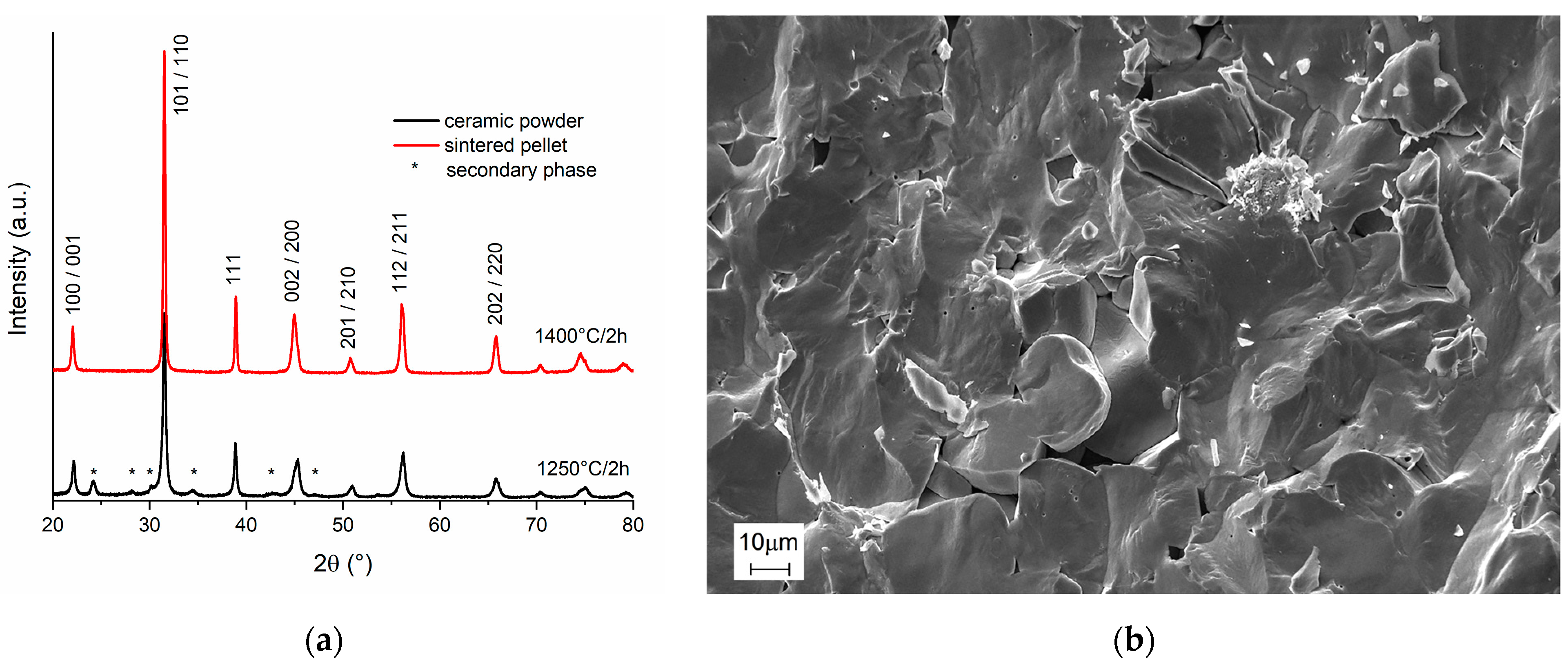
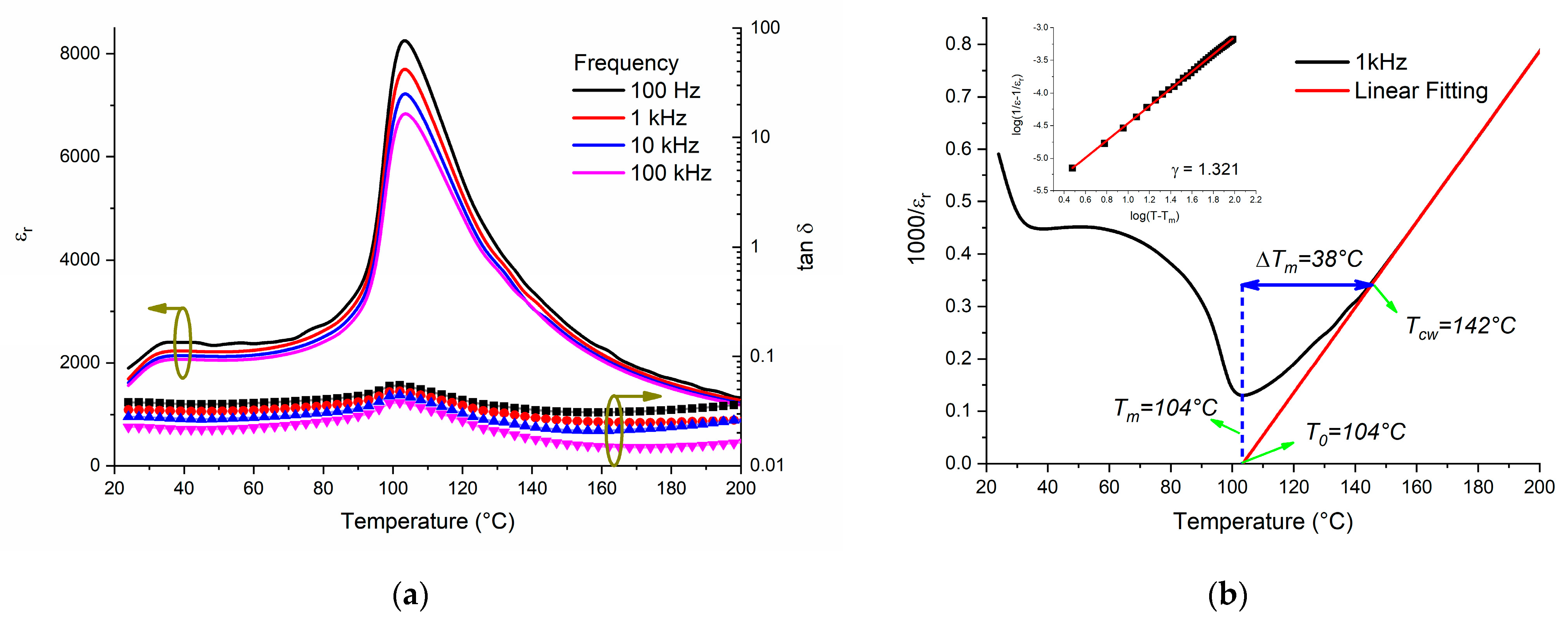
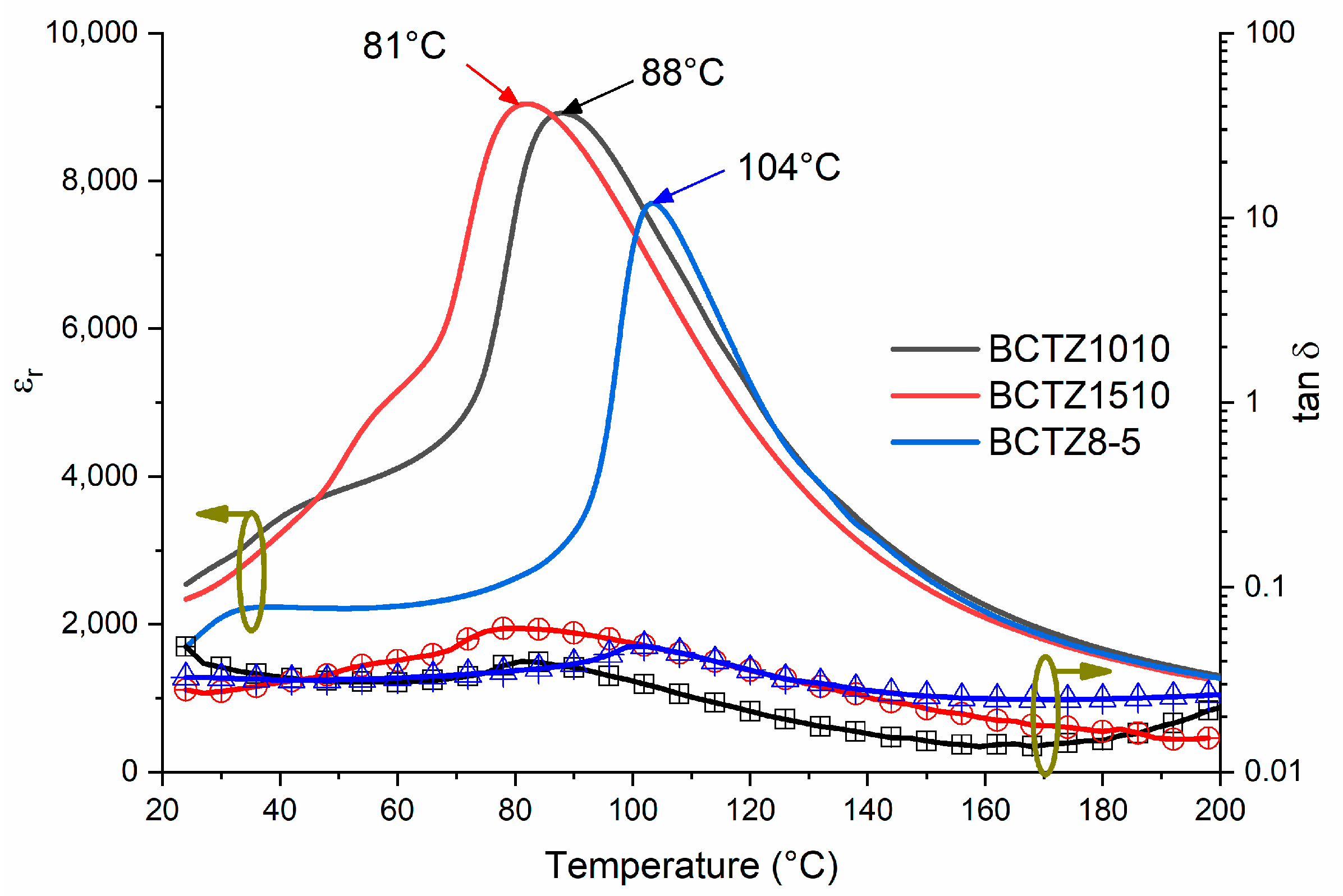
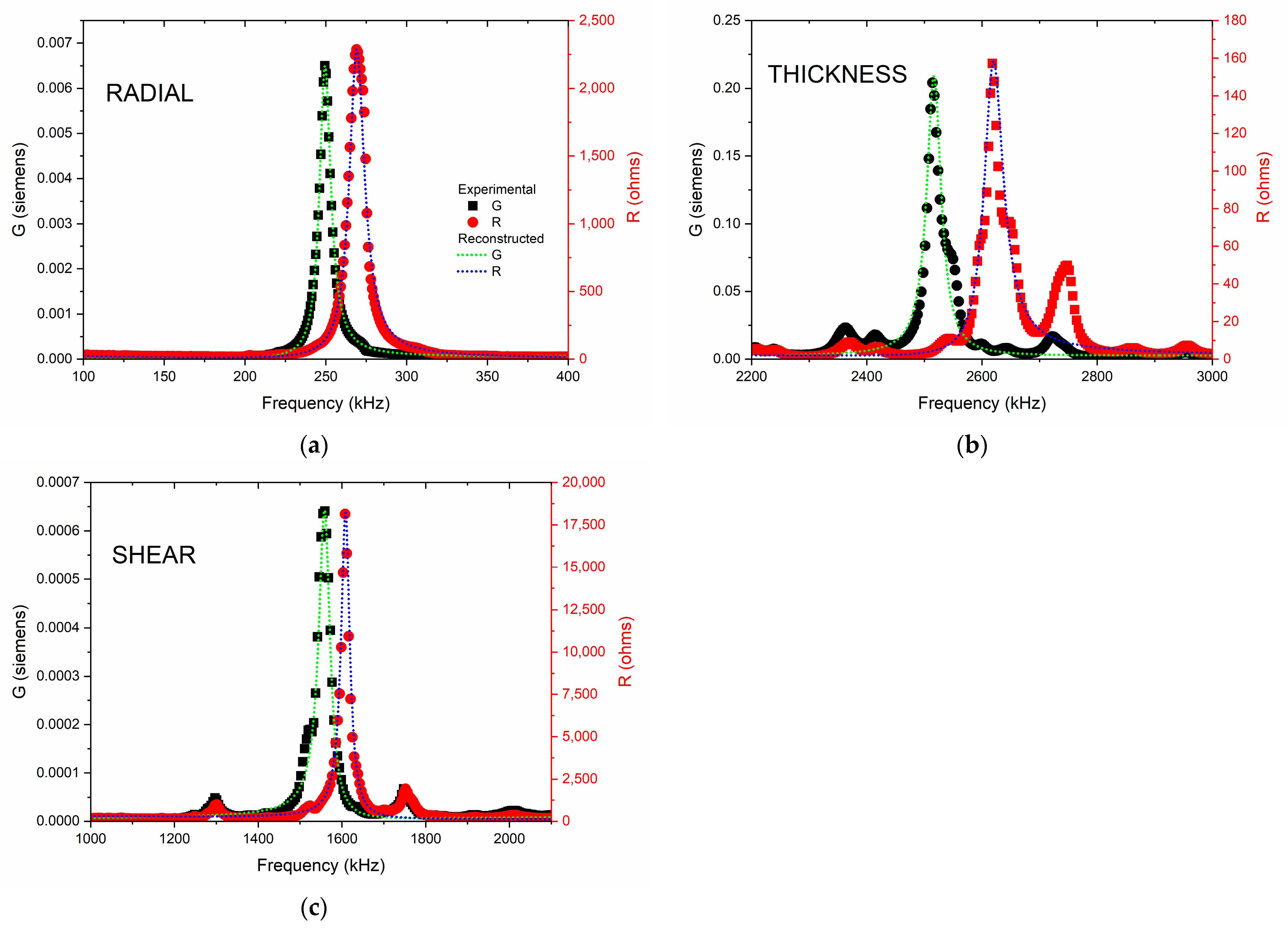
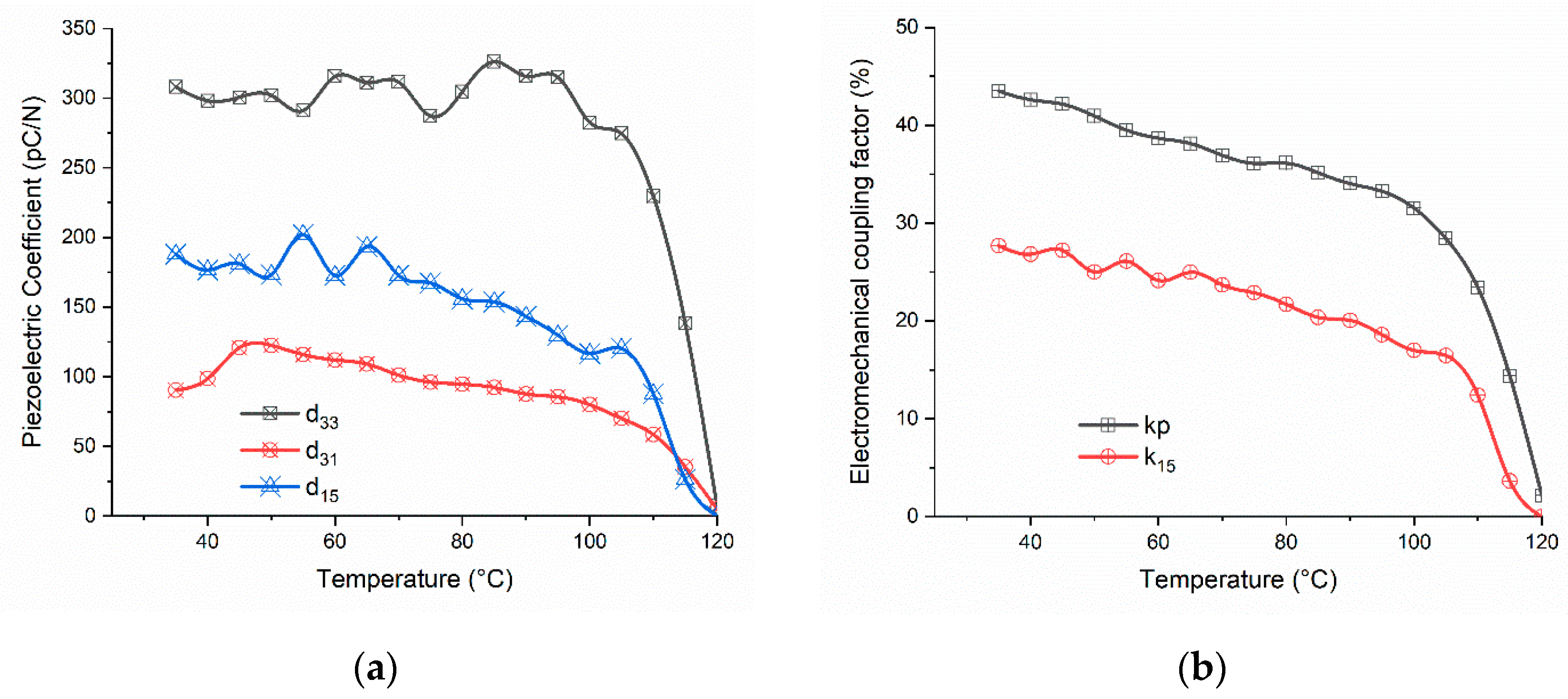
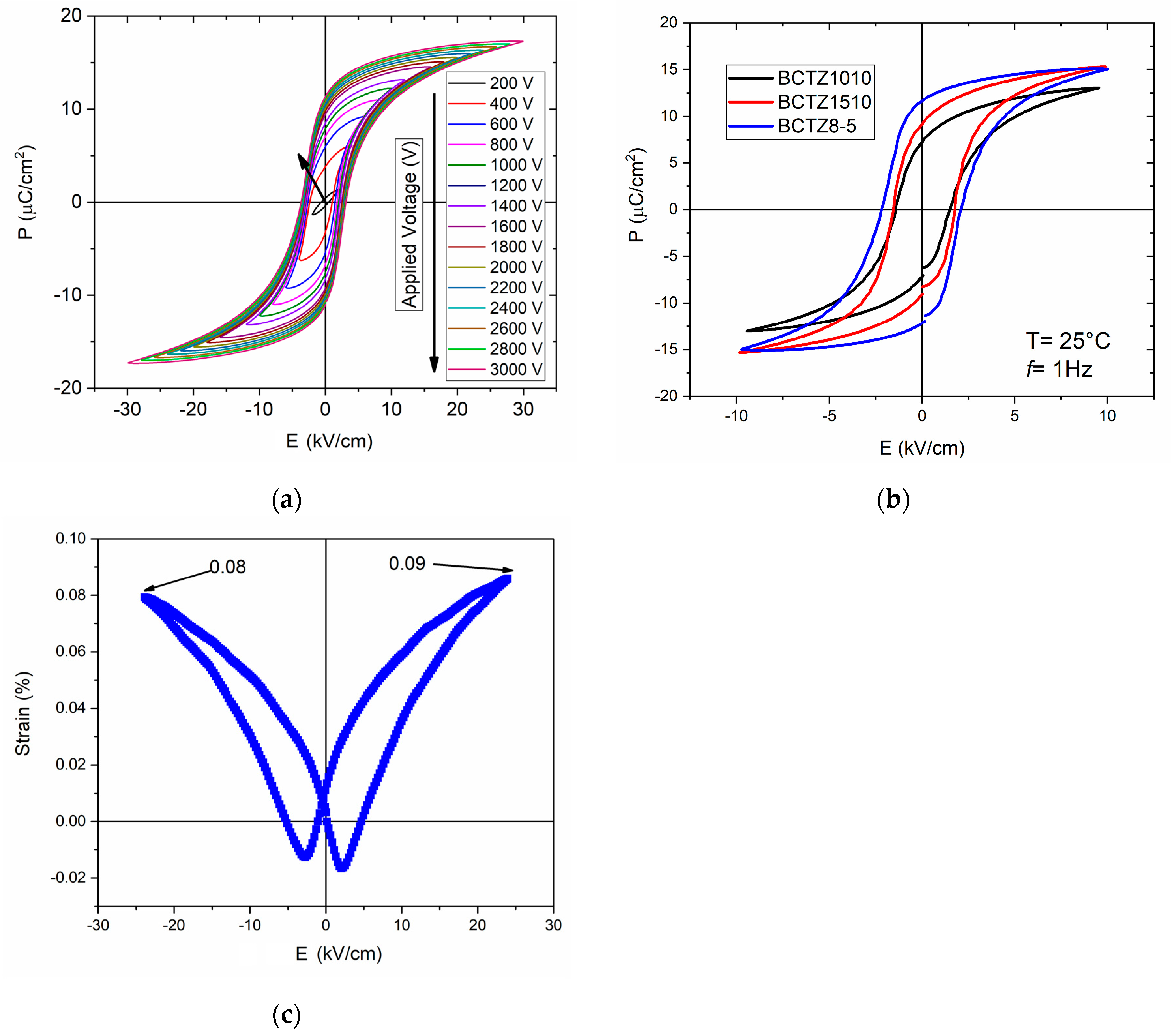
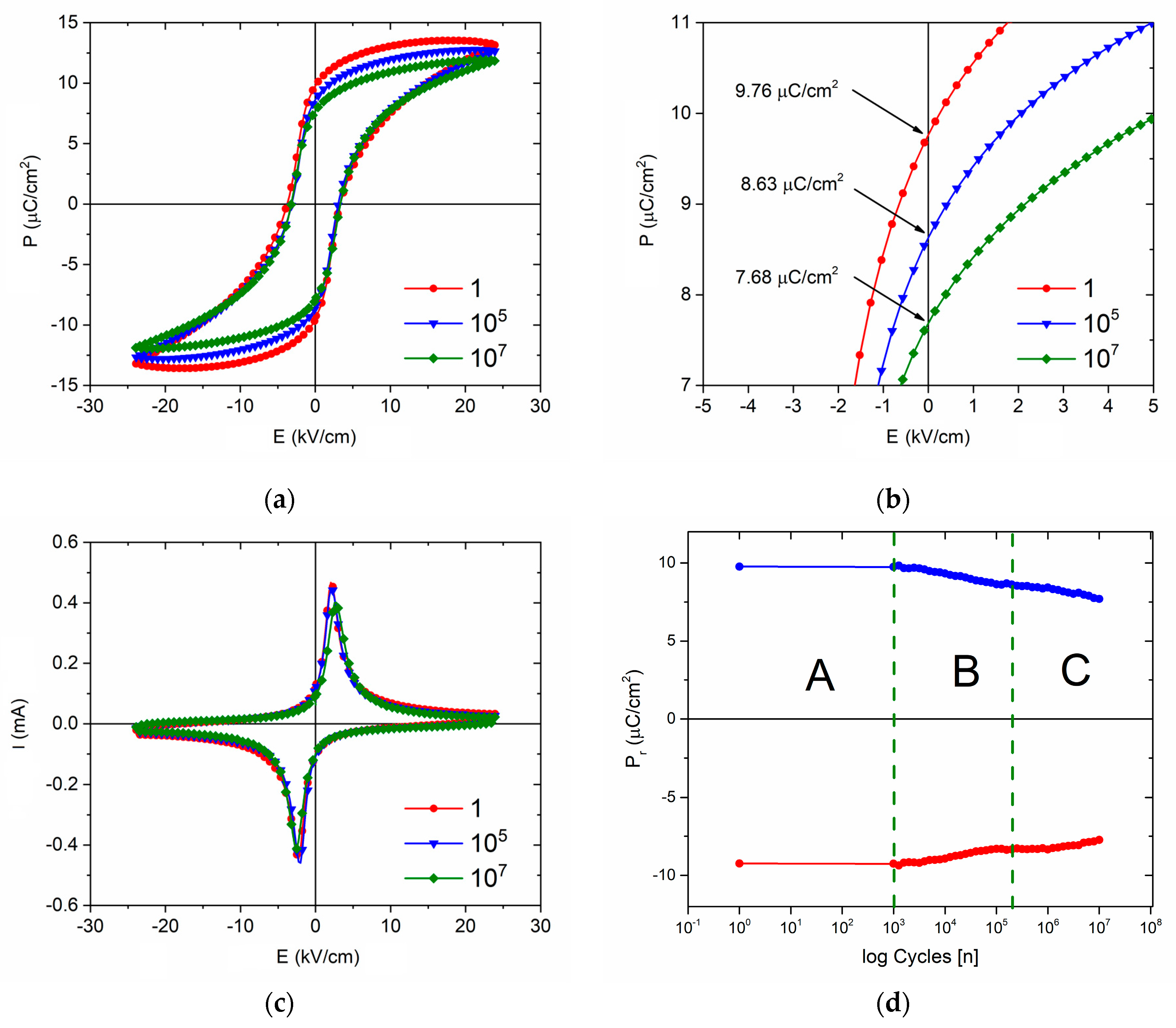
| Elastic stiffness coefficients (cij* = (cij)real + i(cij)img) (1010 N/m2) | ||||||||||
| real | 11.15 | 12.39 | 3.81 | 10.05 | 11.97 | 3.49 | ||||
| Qm | 150 | 51 | 65 | 102 | 75 | 43 | ||||
| Elastic compliance coefficients (sij* = (sij)real + i(sij)img) (10−12 m2/N) | ||||||||||
| real | 11.31 | −5.15 | 22.35 | 11.80 | −4.67 | 24.32 | 32.93 | |||
| Qm | 117 | 83 | 65 | 103 | 106 | 43 | 104 | |||
| Piezoelectric coefficients | ||||||||||
| dij*= (dij)real + i(dij)img (10−12 C/N) | eij*= (eij)real + i(eij)img (C/m2) | gij*= (gij)real + i(gij)img (10−3 Vm/N) | hij*= (hij)real + i(hij)img (108 V/m) | |||||||
| d | d | |||||||||
| real | 320 | −99.06 | 175.72 | 15.91 | 5.14 | 14 | −4.90 | 9.21 | 5.95 | 3.61 |
| imaginary | 3.40 | −14.31 | 0.23 | −0.39 | 0.02 | −0.36 | 0.55 | −0.09 | ||
| (d) measured in a d33-meter Electromechanical coupling factors (%) and frequency numbers (N (kHz.mm)) | ||||||||||
| 28.2 | 27.4 | 1294 | 30.4 | 2514 | 36.9 | 2829 | ||||
| Dielectric permittivity and regression factors of the iterative method | ||||||||||
| 2 | ||||||||||
| real | 2286 | 2330 | 2023 | 1873 | Radial | Thickness | Shear | |||
| tanδ | 0.03 | 0.09 | 0.04 | 0.03 | 0.9929 | 0.9001 | 0.9593 | |||
| Cycles [n] | Ec [kV/cm] | Pr [μC/cm2] | I [mA] |
|---|---|---|---|
| 1 | 3.5 ± 0.2 | 9.5 ± 0.3 | 0.46 ± 0.01 |
| 105 | 3.1 ± 0.1 | 8.5 ± 0.2 | 0.45 ± 0.01 |
| 107 | 3.3 ± 0.1 | 7.7 ± 0.1 | 0.41 ± 0.01 |
Disclaimer/Publisher’s Note: The statements, opinions and data contained in all publications are solely those of the individual author(s) and contributor(s) and not of MDPI and/or the editor(s). MDPI and/or the editor(s) disclaim responsibility for any injury to people or property resulting from any ideas, methods, instructions or products referred to in the content. |
© 2023 by the authors. Licensee MDPI, Basel, Switzerland. This article is an open access article distributed under the terms and conditions of the Creative Commons Attribution (CC BY) license (https://creativecommons.org/licenses/by/4.0/).
Share and Cite
Hernández-Moreno, A.C.; Reyes-Montero, A.; Carreño-Jiménez, B.; Acuautla, M.; Pardo, L. Ferroelectric, Dielectric and Electromechanical Performance of Ba0.92Ca0.08Ti0.95Zr0.05O3 Ceramics with an Enhanced Curie Temperature. Materials 2023, 16, 2268. https://doi.org/10.3390/ma16062268
Hernández-Moreno AC, Reyes-Montero A, Carreño-Jiménez B, Acuautla M, Pardo L. Ferroelectric, Dielectric and Electromechanical Performance of Ba0.92Ca0.08Ti0.95Zr0.05O3 Ceramics with an Enhanced Curie Temperature. Materials. 2023; 16(6):2268. https://doi.org/10.3390/ma16062268
Chicago/Turabian StyleHernández-Moreno, Ana Cristina, Armando Reyes-Montero, Brenda Carreño-Jiménez, Mónica Acuautla, and Lorena Pardo. 2023. "Ferroelectric, Dielectric and Electromechanical Performance of Ba0.92Ca0.08Ti0.95Zr0.05O3 Ceramics with an Enhanced Curie Temperature" Materials 16, no. 6: 2268. https://doi.org/10.3390/ma16062268
APA StyleHernández-Moreno, A. C., Reyes-Montero, A., Carreño-Jiménez, B., Acuautla, M., & Pardo, L. (2023). Ferroelectric, Dielectric and Electromechanical Performance of Ba0.92Ca0.08Ti0.95Zr0.05O3 Ceramics with an Enhanced Curie Temperature. Materials, 16(6), 2268. https://doi.org/10.3390/ma16062268






